
Carmara is a monotypic moth genus of the family Noctuidae. Its only species, Carmara subcervina, is found in Sri Lanka, Japan, Taiwan, Borneo and Australia. Both the genus and species were first described by Francis Walker in 1864.

Hypochrosis is a genus of moths in the family Geometridae. It was erected by Achille Guenée in 1857.
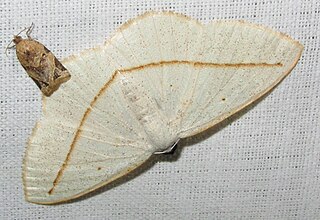
Lomographa inamata is a moth in the family Geometridae first described by Francis Walker in 1860. It is found in Sri Lanka, Japan, China, India and Taiwan.

Hyposidra talaca, the black looper or black inch worm, is a moth of the family Geometridae. The species was first described by Francis Walker in 1860. It is found from India to Indochina, Sundaland, Sulawesi, the Philippines, Sri Lanka, the Solomon Islands, Thailand, Taiwan, New Guinea and Australia, where it has been recorded from Queensland. It is a major defoliating pest in tea plantations.
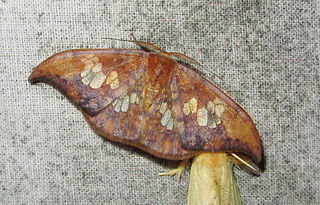
Agnidra specularia is a moth in the family Drepanidae. It was described by Francis Walker in 1860. It is found in Sri Lanka, north-eastern India, Bhutan, Vietnam and Xizang, China.
Brana is a monotypic moth genus of the family Noctuidae. Its only species, Brana calopasa, is found in Sri Lanka and Australia. Both the genus and species were described by Francis Walker, the genus in 1858 and the species in 1859. It It is a serious pest on Berrya cordifolia.

Cleora alienaria is a moth of the family Geometridae first described by Francis Walker in 1860. It is found in Sri Lanka, the Indian subregion to the Andaman Islands, Thailand, Sundaland, Taiwan, and Lesser Sundas as far east as Timor and Christmas Island.
Cusiala raptaria is a moth of the family Geometridae first described by Francis Walker in 1860. It is found in the Indian subregion and Sri Lanka.
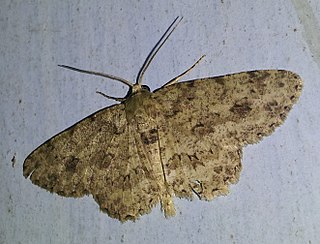
Ectropis bhurmitra, the tea twig caterpillar, is a moth of the family Geometridae. The species was first described by Francis Walker in 1860. A widespread Asian species, it is found around Indo-Australian tropics from India, Sri Lanka and Hong Kong, Taiwan, Thailand, New Guinea to Australian Queensland and the Solomon Islands.

Hypomecis transcissa is a moth of the family Geometridae first described by Francis Walker in 1860. It is found in the Indian subregion and from Sri Lanka to Sundaland.
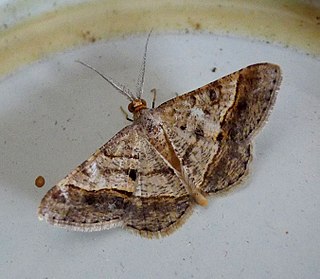
Isturgia pulinda is a moth of the family Geometridae first described by Francis Walker in 1860. The species has a widespread distribution from the African countries of Botswana, Ethiopia, the Gambia, Kenya, Malawi, Mozambique, South Africa, Tanzania, Zambia and Zimbabwe to Saudi Arabia and Yemen towards the Indian subregion and Sri Lanka. In Europe, it is found in the Canary Islands, Spain, Portugal and the Cape Verde Islands.
Mixocera parvulata is a moth of the family Geometridae first described by Francis Walker in 1863. It is found in India, Sri Lanka, Maldives, Vietnam, Ethiopia, Kenya, Madagascar, South Africa, Tanzania and Zimbabwe
Luxiaria phyllosaria is a moth of the family Geometridae first described by Francis Walker in 1860. It is found in Sri Lanka, the north-eastern Himalayas of India, Sumatra, Borneo, the Philippines and Sulawesi.
Ophthalmitis caritaria is a moth of the family Geometridae first described by Francis Walker in 1860. It is found in Sri Lanka.
Ruttelerona cessaria is a moth of the family Geometridae first described by Francis Walker in 1860. It is found in Sri Lanka and South India.
Scardamia bractearia is a moth of the family Geometridae first described by Francis Walker in 1860. It is found in Sri Lanka.
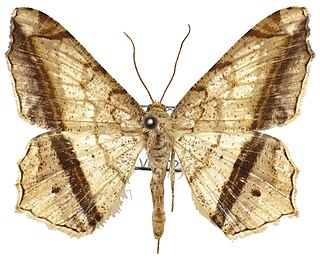
Semiothisa ozararia, is a moth of the family Geometridae first described by Francis Walker in 1860. It is found in the Indian subregion, Sri Lanka, Taiwan, Borneo, Sumatra and Java.
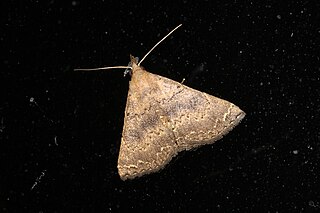
Progonia oileusalis is a moth of the family Noctuidae first described by Francis Walker in 1859. It is found in Sri Lanka, Borneo, India, Taiwan, Japan and the Philippines.

Micraeschus elataria is a moth of the family Erebidae first described by Francis Walker in 1861. It is found in Sri Lanka, Taiwan, Peninsular Malaysia, Singapore, Java and Borneo.
Hypena varialis, is a moth of the family Erebidae first described by Francis Walker in 1866. It is found in India and Sri Lanka.











